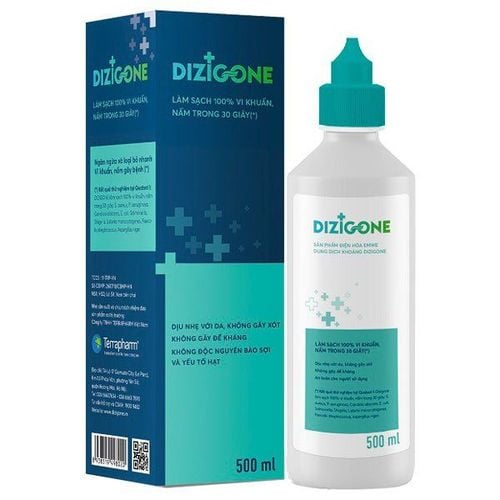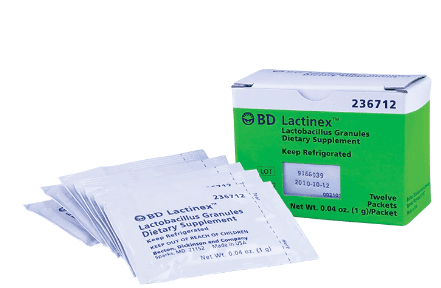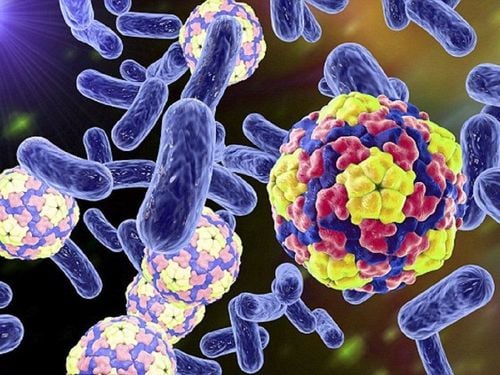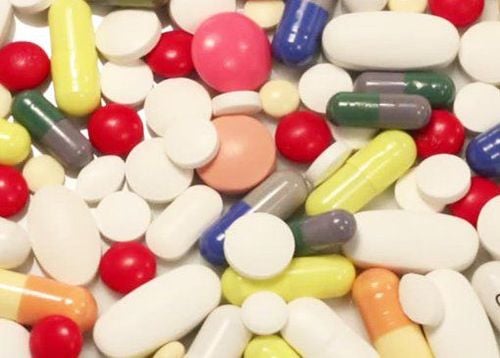This is an automatically translated article.
Microorganisms are distributed everywhere in nature and on both human and animal bodies. Microorganisms include beneficial microorganisms and harmful microorganisms. Of these, only a few species of microorganisms cause disease in humans.
1. What are microorganisms?
Microorganisms are unicellular or multicellular organisms, prokaryotes or eukaryotes, that are very small in size and are usually only visible through a microscope. Microorganisms include bacteria, viruses, fungi, algae and protozoa.
Characteristics of microorganisms are:
Very small size, usually measured in micrometers; Highly absorbed and rapidly metabolized; Fast-growing and thriving compared to other organisms; Strong adaptive capacity, easy to generate mutations; Varieties: The number and types of microorganisms change over time. There are over 100,000 species of microorganisms, including 69,000 species of fungi, 30,000 species of protozoa, 1,200 species of microalgae, 2,500 species of cyanobacteria, 1,500 species of bacteria, 1,200 species of viruses and Rickettsia. In particular, due to the nature of easy mutations, the number of microbial species found is increasing. For example mushrooms: On average, about 1,500 new species are added each year; Wide distribution: Microorganisms are distributed everywhere on earth, even in the most extreme conditions such as craters, Antarctica, ocean floor,... Microorganism groups can be classified based on their benefits as follows:
Beneficial microorganisms: Beneficial microorganisms present in food, the intestinal tract or microorganisms beneficial to plants; Harmful microorganisms: Microorganisms that cause diseases to humans, domestic animals, plants,... The habitats of microorganisms include: Water environment, soil environment, and terrestrial environment. - atmosphere and biological environment (people, animals, plants).

Vi sinh vật có kích thước vô cùng nhỏ, phải sử dụng kính hiển vi để quan sát
2. The distribution of microorganisms in the human body
2.1 Characteristics of microorganisms in the human body
There is a population of microorganisms called the microflora that live on a healthy human body. The types of microorganisms commonly found on the human body can be divided into: parasitic microorganisms harmful to humans, symbiotic microorganisms beneficial to both humans and microorganisms, intermediate types are microorganisms commensal creature. Based on the time that microorganisms reside on the body, they can be divided into 2 groups as follows:
Frequent presence: Existing on the human body annually or permanently; Temporary presence: Infrequently present in the human body, usually only seen for a few hours, days or weeks. The role of the normal microbiome on the human body:
Bacteria synthesize and secrete some necessary enzymes for them, and at the same time help the body enhance nutrient absorption. Specifically, intestinal bacteria (E.coli) produce vitamin K, vitamin B12,...; Local microorganisms have the ability to prevent the entry of pathogenic bacteria from other places; Microorganisms capable of stimulating the production of cross-reactive antibodies. 2.2 Distribution of microorganisms on the human body There are more than 200 species of microorganisms that exist on the human body and they are mainly distributed in the following parts:
Microorganisms on the skin
Skin is the contact part Direct contact with the environment, there are many types of parasitic microorganisms on the skin and mainly microorganisms present temporarily. These microorganisms get food on the skin from the secretions of sweat and sebaceous glands. They are more densely distributed in moist areas such as the scalp, face, between fingers, toes, and armpits. Depending on the location, the number of bacteria on the skin can be from 102 to 103 microorganisms/cm2 of skin.
On the skin often exist the following microorganisms: Gram-positive cocci (Peptostreptococcus, Micrococcus sp. and S.epidermidis) and gram-positive bacilli (Propionibacterium, Corynebacterium, Bacillus, Diphtheroid). S. Epidermidis is the causative agent of disease in hospitalized patients with catheterized catheters.
Regular cleaning and bathing can reduce up to 90% of microorganisms on the skin. However, after a few hours they are quickly replenished from the sebaceous glands, sweat glands, surrounding skin and from the environment. Therefore, people need to regularly clean the body to control the proliferation of microorganisms on the skin.

Vi sinh vật tồn tại ở trên da của con người
In the respiratory tract, the distribution of microorganisms is as follows:
Microorganisms in the nose: S.epidermidis, Corynebacterium, S.aureus and Streptococcus; Microorganisms in the upper respiratory tract: S.pneumoniae, Herpes, Streptococcus viridans group, S.aureus, M.Catarrhalis, Adeno, Rhino; Microorganisms in the oropharynx: Mainly streptococci; Microorganisms in the lower respiratory tract (trachea, bronchi, alveoli): Normally, there are no bacteria in the lower respiratory tract. Microorganisms in the digestive tract
In the gastrointestinal tract, microorganisms are distributed as follows:
Microorganisms in the mouth: With favorable conditions for bacteria to grow (temperature, food residue, alkaline saliva pH mild), there is a large amount of bacteria in the mouth. Bacteria in the mouth are mainly streptococci (S.sanguinis, S.mitis, S.salivarius, S.Mutans.), anaerobic cocci (Veillonella, Peptostreptococcus), staphylococcus (S.epidermidis), Lactobacillus, Gram-negative diplococci (Moraxella catarrhalis, Neisseria). Less common oral microorganisms include S.aureus, Enterococcus, C.albicans; Stomach microorganisms: Most microorganisms are destroyed in the stomach, and the acidic pH of the stomach keeps the microbiome at a minimum of 103 microorganisms/gram of food. Some bacteria that can live in the stomach are H.Pylori bacteria and tuberculosis bacteria. People with H.pylori can develop peptic ulcer disease; Intestinal microbiota: Intestinal pH > 7, alkaline. There are few microorganisms in the small intestine because there are lysing enzymes here. As you go downhill, the number of microorganisms increases. In the duodenum, there are 103 bacteria/ml of fluid, 108-1011 microorganisms/gram in the colon. Microorganisms make up 10 - 30% of the weight of feces. The bacteria commonly found in the small intestine are Enterococcus, Lactobacillus, and Candida albicans. The bacteria that normally exist in the normal human colon are: anaerobes (Bacteroides, Lactobacillus, Clostridium, Peptococcus) and some aerobic and facultative anaerobes with low numbers such as: E.coli, Proteus, Klebsiella, Lactobacillus, Enterobacter, Enterococcus, B.cereus, Candida spp,... Intestinal bacteria play an important role in vitamin A synthesis, metabolism of bile pigments, bile acids, and absorption of nutrients. nutrients and resist the invasion of pathogenic bacteria. Urinary tract microorganisms
Normally, the urinary tract is sterile and urine is free of microorganisms. The urinary tract at the outermost part of the urethra has a few species of bacteria such as: E.coli, S.epidermidis, Enterococcus faecalis, alpha-hemolytic streptococci, Proteus. They can be present in the primary urine with counts below 104 microorganisms/ml.
Microorganisms in the genitals
In infants and young children: The vagina contains bacteria such as Lactobacillus acidophilus, cocci and bacilli (E.coli); In women from puberty to menopause: Under the influence of estrogen in the blood, vaginal epithelial cells have a lot of glycogen. Lactobacillus has the ability to convert glycogen into lactic acid, making the vaginal pH acidic (pH 4 - 5), against the invasion of pathogenic microorganisms and fungi. In the case of a woman taking antibiotics or entering menopause, Lactobacillus is inhibited, fungi and many other bacteria will thrive and cause inflammation. The microorganisms commonly present in the vagina include: Lactobacillus, Bacteroides, Peptostreptococcus, S.epidermidis, Enterococcus, G.vaginalis, less commonly group B streptococcus, intestinal bacteria and C.albicans. Microorganisms always exist in the human body, which includes both beneficial microorganisms and harmful microorganisms. Each person needs to maintain a healthy and scientific lifestyle to stimulate the growth of beneficial bacteria and control and fight the invasion and development of harmful microorganisms.
Please dial HOTLINE for more information or register for an appointment HERE. Download MyVinmec app to make appointments faster and to manage your bookings easily.













